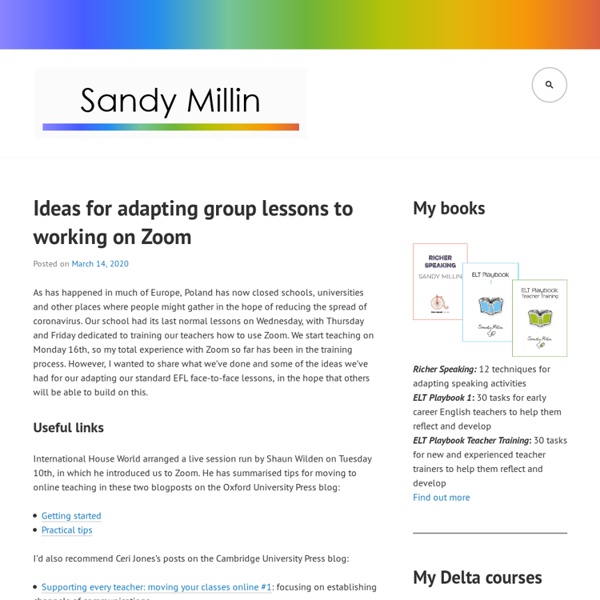Visible Thinking
Purpose: What kind of thinking does this routine encourage? This routine encourages students to make careful observations and thoughtful interpretations. It helps stimulate curiosity and sets the stage for inquiry.
7 Good Examples of Gamification in Education
About ETR Community EdTechReview (ETR) is a community of and for everyone involved in education technology to connect and collaborate both online and offline to discover, learn, utilize and share about the best ways technology can improve learning, teaching, and leading in the 21st century. EdTechReview spreads awareness on education technology and its role in 21st century education through best research and practices of using technology in education, and by facilitating events, training, professional development, and consultation in its adoption and implementation.
Moving your classes online #2
Published 13 March 2020 This is a follow up post from Ceri Jones who continues to share advice on how teachers can feel prepared with teaching students and moving classes online. Ceri Jones is a teacher, trainer and materials writer based in Spain. She is part of the author team for our courses Eyes Open and Evolve as well as an online tutor for The Consultants-E. 1. Structuring your online classes
How to use Roleplay in ESL - Eslbase.com
Learning a language is a complex and long process as anyone who has tried will agree. One of the most difficult and frustrating things is making the transition from the classroom to the ‘real’ world. In the classroom, everyone knows you are a student and mistakes are allowed, and the environment is contained and safe. Speaking another language outside the classroom is completely different and often students are lost at sea as soon as they step outside the door. Lists of memorized vocabulary are suddenly useless when ordering in a restaurant.
Good Enough Is Good Enough
Published 19 March 2020 Philip Kerr has a message to all teachers who have made the transition from teaching in the classroom to online: If this is the end of the (teaching) week for you, well done – you’ve made it. I’ll keep this short! You may be busy…
Offline Choice Boards: How Are You Integrating Offline Learning into Your Online Class?
Schools in California will not reopen this year. Teachers are scrambling to move their offline courses online to ensure that students continue learning for the remainder of the school year. Understandably, the focus is on online learning as that is a new and unfamiliar learning landscape for a lot of educators. I am fielding questions about how to set up online courses, design online lessons, and offer small group instruction and support via video conferencing. As an advocate of blended learning, I want teachers to strive for a healthy balance of online and offline tasks as students engage in distance learning. As a parent of two children, I worry about kids staring at screens for hours at a time.
The World Factbook
People from nearly every country share information with CIA, and new individuals contact us daily. If you have information you think might interest CIA due to our foreign intelligence collection mission, there are many ways to reach us. If you know of an imminent threat to a location inside the U.S., immediately contact your local law enforcement or FBI Field Office. For threats outside the U.S., contact CIA or go to a U.S. Embassy or Consulate and ask for the information to be passed to a U.S. official. Please know, CIA does not engage in law enforcement.
Moving Your Classes Online #1
Published 13 March 2020 To help support all teachers who now have to teach from home due to the Coronavirus outbreak, we have created a series of blog posts with expert advice on how to move your classes online. To begin, here’s a message from Eric Baber, Director of Professional Learning and Development, introducing the blog series. Moving your classes online: getting started It can be a daunting experience when you’re suddenly required to move all your face-to-face classes online with little or no advance notice, as has been happening to a number of teachers in various places around the world over the last month and more. In this blog post we’ll look at some basic steps to take that will hopefully smooth the transition.
Teaching Your Adult English Class Online
Published 19 March 2020 Our blog series continues to help English teachers move their classes online in view of many institutions being closed due to the Covid-19 virus. Today’s post is by Carol Rainbow, who offers suggestions for teaching your adult English class online. The virtual learning environment When teaching groups of adults online, planning for learning is slightly different to what you may have prepared for face to face class work. Ideally you need a virtual learning environment (VLE) such as the Cambridge Learning Management System (CLMS).



